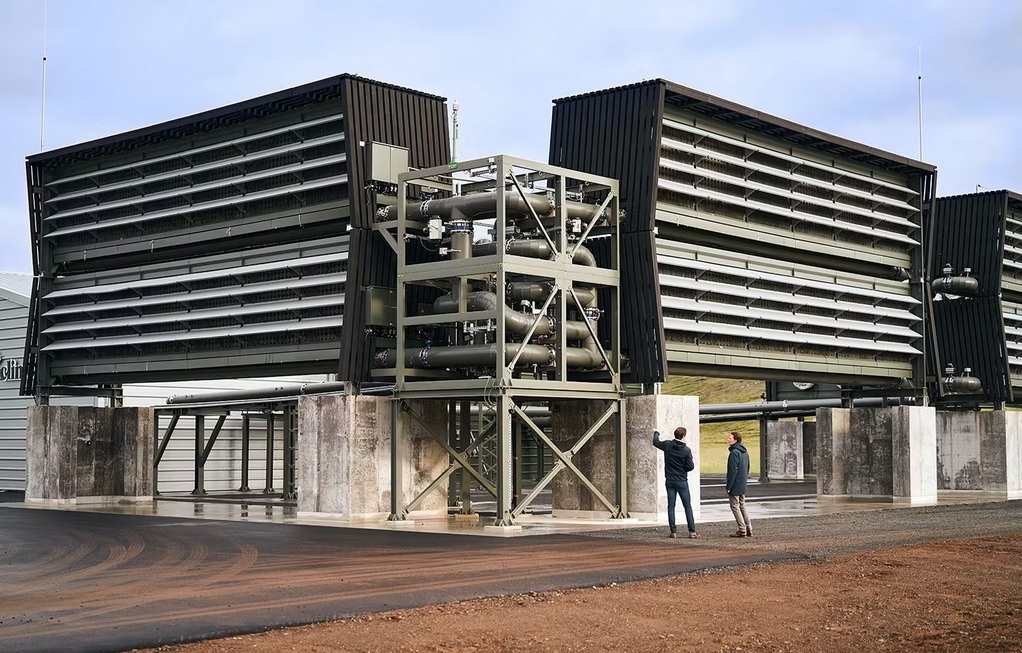There’s been a stampede of investment into direct air capture, but some advocates worry the carbon capture process may not be scaled up fast enough to make an impact.
Direct air capture is a new technology that vacuums carbon dioxide out of the atmosphere. The CO2 is trapped by a special filter inside a giant collector – each the size of a shipping container. In Iceland, home to the world’s first commercial direct air capture plant, CO2 is then sent to be buried deep underground in porous volcanic rock, where it hardens to stone in less than two years.
Scientists estimate carbon capture needs to remove 10 billion tons of carbon dioxide annually, at the same time as there are drastic cuts in fossil fuels. ORCA, the world’s first and largest direct air capture and storage plant, can take out the emissions of about 800 cars, or 4,000 tons of CO2. however, scaling direct air capture is a huge challenge.
As it exists now, direct air capture is expensive and energy intensive. In Iceland, that energy is geo-thermal— renewable and green.
Technically the scaling up process can be done, but that it’s not a decision that one company can make alone.
The International Panel on Climate Change, which works with the top climate scientists in the world, has endorsed direct air capture as part of a suite of new technologies that can reduce oil and gas emissions.
Nearly 40 billion tons of oil and gas emissions are spewing into the atmosphere every year, according to the National Oceanic and Atmospheric Administration (NOAA.) It’s primarily emitted from the transportation, construction and power industries. The heat-trapping effects of carbon dioxide make it by far the most damaging greenhouse gas and contributor to climate change, NOAA said in a 2022 report.
As it exists now, direct air capture is expensive and energy intensive. In Iceland, where ORCA is located, that energy is geo-thermal— renewable and green. That’s not the case elsewhere. Governments in Europe and the United States have dangled billions of dollars of subsidies and tax incentives to encourage companies to take the plunge.
Direct air capture is a new technology that vacuums carbon dioxide out of the atmosphere.
Occidental Petroleum has staked out the lead in the direct air capture business in the U.S. It has set aside more than $1 billion to build what will be the world’s largest direct air capture plant. Oil companies have been capturing and injecting CO2 for decades, not to bury the CO2, but to flush out more oil. It’s called enhanced oil recovery and it has many in the carbon capture industry wary that this technology will give oil companies cover to pump more oil.
Carbfix, which is the Icelandic company that pioneered the method to inject captured carbon into the ground, told 60 Minutes that carbon capture can never be an excuse for doing business as usual. Many others in the field agree.
Some argue that using carbon dioxide sucked out of the air to flush out more oil means the oil produced will be what she calls carbon neutral.
Producing oil this way is essential in the transition to a green economy. Airlines and ships, for example, need to run on fossil fuels until a sustainable alternative is found. That could take years. Until then using CO2 to get that oil helps keep a lid on emissions.
Critics of big oil are suspicious and many feel the industry isn’t moving fast enough to avoid a climate catastrophe. On that point, Occidental Petroleum plans to build 130 more direct air capture plants by 2035 around the globe.
Meanwhile in Iceland, Carbfix is working around the clock to build a massive underground disposal site for CO2, capable of handling 3 million tons a year. It’s the first industrial-scale waste disposal site for CO2.
But they admit that don’t know if it will happen fast enough to help with climate change.
Climeworks is now building a new plant in Iceland 10 times the size of ORCA. Both Carbfix and Climeworks will be expanding to the U.S. Neither plans to work with the oil industry.
Tags: Carbfix, Carbon Capture Technology, Climeworks, CO2, ORCA



Recent Posts
Babcock’s LGE Business Secures Contract for Marine Ammonia Fuel System to Advance Shipping Decarbonisation
Associated Terminals Deploys Liebherr’s All-Electric Cranes in Landmark Move Toward Cleaner Cargo Handling
Sanmar delivers fully electric emissions-free tug to major global operator Svitzer
Kolkata Dock deploys first-ever electric mobile cranes
ONGC orders two ethane carriers from Mitsui O.S.K. Lines
IndianOil to Commission India’s Largest Green Hydrogen Plant by 2027
IMI Greater Noida Signs MoU with IME (I) to Launch A New Student Chapter
GCMD Completes World’s First Pilot Demonstrating Full Carbon Value Chain from Ship-Captured CO2 in China